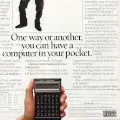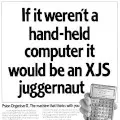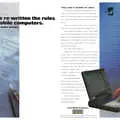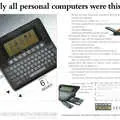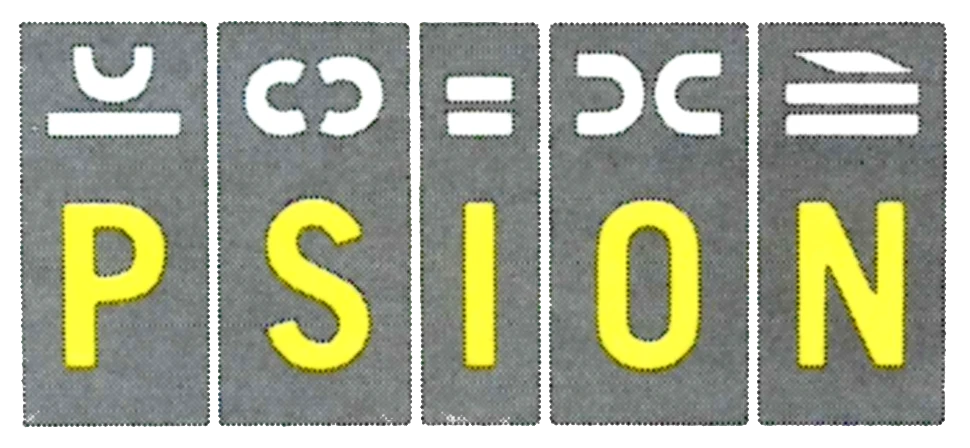
Psion Advert - October 1983
From Popular Computing Weekly

The best software on earth comes from Psion
Psion had been founded in 1980 by David Potter, who had been born in South Africa but who had moved to the UK to study science at Cambridge University. He went on to get a doctorate at Imperial College, London, and then did a brief stint as assistant professor of UCLA.
The company - whose name was an abbreviation of Potter's Scientific Investments, plus "on" to make it unique "like Exxon" - was started with around £50,000 in cash that Potter had made from well-picked stock market investments after the crash of 1974, plus extra raised from a second mortgage on his house. Potter said, in an interview for Personal Computer World in September 1991 of the launch that:
"I didn't start with a great big business plan. What I did say was, right, I need to rapidly generate a turnover and basic profit, and then from there, once I get a trading picture going, I can bring in other people for development purposes. So what I did was to get into software publishing".
His first package was a set of utilities for Acorn's Atom, a machine which he called "ropey" and which he claimed had used a US-standard 60Hz video controller, and that Acorn was relying on the fact that 60% of the UK's 50Hz televisions would be able to lock onto the signal anyway.
When the ZX80 was launched, Potter decided to concentrate on that instead, a move which proved to be a turning point as Psion was then helped along by the relative success of the tiny micro.
From then on, Psion became the official software supplier, developing packages both under its own name and that of Sinclair, including the advertised packages for the Spectrum, among which were some early application programs - VU-CALC and VU-FILE.
As well as the introductory cassette called "Horizons" that shipped with each machine, the company already had another 12 titles it was selling under the Sinclair brand.
However, it had already been approached around the spring of 1983 "with a view to developing material for [Sinclair's] new, professional, machine".
This was the QL and would prove to be Psion's biggest deal to date, not least because it had been rumoured that both Digital and Microsoft and been approached.
Psion, although not very long established at the time, was, according to Managing Director David Potter, "an ambitious company". He continued:
"We aren't into producing specialist programs to keep legal records or patient dose rates. We wanted instead to be producing the fundamental software tools - the word processors and spreadsheets - a market dominated by the big US software companies".
The end result of lengthy discussions with Sinclair was a complete software suite for the QL which "[took] the hardware to its limits" and "surprised Sinclair with what we [Psion] achieved".
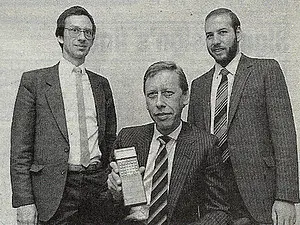
Psion's management team, including David Potter (middle) and Colly Myers (right), © Popular Computing Weekly, May 1986The work on the four packages was split in to, not surprisingly, four teams, with development of graphing package "Easil" headed by Martin Brown, whilst the word processor - "Quill" - was headed by Martin Stamp.
Colly Myers looked after the spreadsheet "Abacus" - which Myers said combined "the style of Supercalc with the power of Multiplan" - and Charles Davies with database package "Archive", said by Potter to be "probably the most powerful database program on any micro, full stop". Potter continued:
"The four packages are state-of-the-art products. Better, more powerful and conceptually more advanced than anything on any machine under £5,000"[1].
As there was no hardware available, Psion had to invest in a development system based on a DEC VAX Minicomputer. This could emulate different processors, including the 68008 of the QL, which meant the company could develop its software before the QL was ready.
This was just as well as the QL itself was hideously late, finally shipping on the evening of Monday 30th April 1984, in the process making a mockery of its previous working title of ZX83.
Sinclair started supplying bits of the hardware and operating system to Psion around November of 1983, which was when Psion could finally start porting it and testing it for real. However, as Potter recalled in his Personal Computer World interview:
"I went away on holiday in December 1983, and while I was away I got a telephone call from Charles [Davies] saying 'They're absolutely mad, they say they're going to launch the ZX83 [in] January and they want all our software up and running'. I said they're daft, but I got on an aeroplane and came back because that's what they'd decided to do and it wasn't for us to stop them. Anyway, they had this huge launch, very impressive, and then nothing happened, and they started getting cheques, and no machines, nothing, and we were horrified. Time went by. Eventually they started getting slated in the press and on, I think, 31st March, they had to say they were going to ship. Then in April they came out in dribs and drabs and of course they weren't working properly and there were all kinds of problems[2]".
Within a year, Sinclair and Psion had released version 2 of the QL's productivity suite in an admission that the original had been somewhat flawed.
If nothing else, the second version was advertised as running in machine code, a possible admission that version 1 had been written, at least in part, in Basic[3].
Colly Myers ended up as Psion's Managing Director before becoming founder CEO of Symbian, when it was launched in June 1998. He left Symbian in 2002[4].
Psion itself would launch the first of its famous Organisers in 1984 and continue through several variations, before moving in to other technology such as its range of GoldCard PCMCIA modems in the latter half of the 1990s, following its acquisition of Dacom.
Date created: 16 November 2015
Last updated: 11 December 2024
Hint: use left and right cursor keys to navigate between adverts.
Sources
Text and otherwise-uncredited photos © nosher.net 2025. Dollar/GBP conversions, where used, assume $1.50 to £1. "Now" prices are calculated dynamically using average RPI per year.

